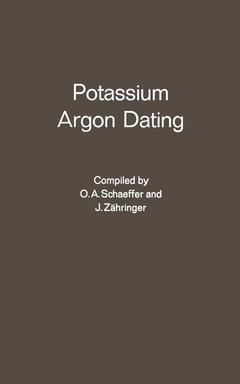Potassium Argon Dating, Softcover reprint of the original 1st ed. 1966
Langue : Anglais
Auteur : Schaeffer O. A.

Perhaps no dating method has the wide range of applicability as does the potassium argon dating method from either consideration of the ranges of ages which can be dated or the availability of suitable material to date. Minerals as young as tens of thousands of years to minerals billions of years old have been successfully dated. Many minerals retain for times of the order of billions of years the daughter, Ar40, and many minerals contain as a component K40 the parent element, potassium being a common element in the earth's crust. As a result, most rock contains at least one mineral which can be successfully dated by the potassium argon method. Even though this method has been applied for over fifteen years, there is as yet no work which summarizes the experimental techniques and the results available. The sixtieth birthday ofW. GENTNER, one of the pioneers in this field of research, is a suitable time to present such a summary.
History of the K-Ar Method of Geochronology.- Determination of Radiogenic Argon.- I. Introduction.- II. Extraction and separation of argon.- A. General remarks.- B. Heat extraction method.- a) Furnaces.- b) Apparatus and melting process.- C. The chemical flux method.- D. Separation of argon from the extracted gas.- E. Storage of argon samples.- Additional literature to chapter II.- III. Determination of argon.- A. Volumetric method.- B. Mass spectrometric analysis.- a) Introduction.- b) Principle of the method.- c) Special details on argon analysis.- d) Operation of the mass spectrometer.- e) Calculation of ages.- IV. Calibration.- A. General remarks.- B. Preparation of gas standards with an exactly determined amount of gas.- C. Direct calibration with “pipettes”.- D. Isotope dilution method.- Additional literature to chapter IV.- V. Neutron activation analysis.- Potassium Analysis.- I. The physical and chemical properties of potassium and its isotopes.- II. Terrestrial and extraterrestrial abundance of potassium. The potassium minerals.- III. Chemical methods of potassium separation and determination.- 1. Precipitation reactions and gravimetric techniques.- Perchlorate method.- Chloroplatinate method.- Tetraphenylboron method.- Cobaltnitrite method.- 2. Ion exchange chromatography.- Batch operation.- Column operation.- Separations of alkali elements with cation exchangers.- Separations of alkali elements with anion exchangers.- 3. Flame photometry.- IV. Physical methods of potassium determination.- 1. X-ray fluorescence analysis.- 2. Mass spectrometric isotope dilution analysis.- 3. Neutron activation analysis.- V. Applications of potassium analysis to K-Ar dating.- 1. Terrestrial material.- 2. Tektites.- 3. Stony meteorites.- 4. Iron meteorites.- The Diffusion of Argon in Potassium-Bearing Solids.- 1. Introduction.- 2. Principles of diffusion.- 2.1. Fundamental laws.- 2.2. Boundary conditions and initial values.- 2.3. Practical mathematical forms.- 2.4. Irregularly shaped crystals.- 2.5. Samples containing a variety of grain sizes.- 2.6. Samples of complex composition.- 2.7. Activation energies.- 2.8. Non-volumic diffusion.- 3. Correction of ages.- 4. Experimental methods.- 4.1. Mass spectrometry.- 4.2. Neutron activation.- 4.3. Isothermal heating.- 4.4. Linear heating.- 5. Experimental results.- 5.1. Synthetic single crystals.- 5.2. Minerals.- 5.3. Polycrystalline systems.- 5.4. Glasses.- 5.5. Conclusions.- 6. The thermal history of minerals.- 7. Other possible influences on the K-Ar ages.- 8. Summary.- K-Ar Dating of Precambrian Rocks.- Losses of radiogenic argon.- The future of Precambrian K-Ar dating.- K-Ar Dating of Plutonic and Volcanic Rocks in Orogenic Belts.- Conditions for age determination. Accuracy of dates.- Materials used for dating plutonic rocks.- Materials used ior dating volcanic rocks.- Calibrating the stratigraphie record.- Interpretation of dates in an orogen.- The model orogen.- The “metamorphic veil”.- Penetrating the veil.- K-Ar dates in the Appalachian orogen.- K-Ar Dating of Sediments.- The study of glauconite.- Comparison of glauconite ages with accepted time scales.- The use of glauconite in dating the Proterozoic.- Evidence from glauconite on the age of the base of the Cambrian.- Measurements on whole-rock samples of shale or its mineral components.- K-Ar age measurements on pelagic sediments.- The age of detrital components in clastic sediments in the study of paleotectonics.- The Problem of Contamination in Obtaining Accurate Dates of Young Geologic Rocks..- Contamination.- Contamination from reworking of primary tuffs by erosional processes..- Summary.- Tektites.- I. Introduction.- II. Experimental technique for application of K-Ar method to tektites.- III. Potassium argon dates of tektite strewn fields.- IV. Potassium argon ages and the origin of tektites.- V. Potassium argon dating of glass from large meteorite impact craters.- K-Ar Ages of Meteorites.- A. Stone Meteorites.- 1. The classification of meteorites.- 2. Sources of Ar-isotope variations.- 3. K-content and isotopic composition.- 4. K-Ar ages.- 5. Argon losses and comparision with the He4-ages.- 6. Comparison with Rb-Sr and Pb-Pb ages.- Rb-Sr.- Pb-Pb.- 7. Break-up and cosmic ray-exposure ages.- B. Iron Meteorites.- 1. Experimental.- 2. Results.- 3. Summary.- Literature.
Date de parution : 01-1966
Date de parution : 12-2012
Ouvrage de 234 p.
15.2x22.9 cm
Disponible chez l'éditeur (délai d'approvisionnement : 15 jours).
Prix indicatif 52,74 €
Ajouter au panier
© 2024 LAVOISIER S.A.S.
